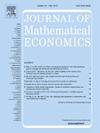关于一类具有单峰效用函数的策略证明社会选择对应关系
IF 1
4区 经济学
Q3 ECONOMICS
引用次数: 0
摘要
我们考虑了构建基于选民偏好选择备选方案集的策略证明规则的问题,该规则在文献中被建模为社会选择对应关系(SCC)。我们关注Barberà等人启发的两个领域限制。(2001)在单峰效用函数的背景下。我们发现,对于较窄的域,仅顶部、一致和策略证明SCC的集合与两个最小-最大规则的并集类一致(Moulin,1980)。对于更广泛的域,SCC的集合与两个“相邻”的最小-最大规则的并集类一致,这意味着这两个规则的相应参数必须是相同的或连续的备选方案。本文章由计算机程序翻译,如有差异,请以英文原文为准。
On a class of strategy-proof social choice correspondences with single-peaked utility functions
We consider the problem of constructing strategy-proof rules that choose sets of alternatives based on the preferences of voters, modelled as Social Choice Correspondences (SCCs) in the literature. We focus on two domain restrictions inspired by Barberà et al. (2001) in the context of single-peaked utility functions. We find that for the narrower domain, the set of tops-only, unanimous, and strategy-proof SCCs coincides with the class of unions of two min–max rules (Moulin, 1980). For the broader domain, the set of SCCs coincides with the class of unions of two ‘adjacent’ min–max rules, meaning the corresponding parameters for the two rules must be either the same or consecutive alternatives.
求助全文
通过发布文献求助,成功后即可免费获取论文全文。
去求助
来源期刊

Journal of Mathematical Economics
管理科学-数学跨学科应用
CiteScore
1.70
自引率
7.70%
发文量
73
审稿时长
12.5 weeks
期刊介绍:
The primary objective of the Journal is to provide a forum for work in economic theory which expresses economic ideas using formal mathematical reasoning. For work to add to this primary objective, it is not sufficient that the mathematical reasoning be new and correct. The work must have real economic content. The economic ideas must be interesting and important. These ideas may pertain to any field of economics or any school of economic thought.
 求助内容:
求助内容: 应助结果提醒方式:
应助结果提醒方式:


